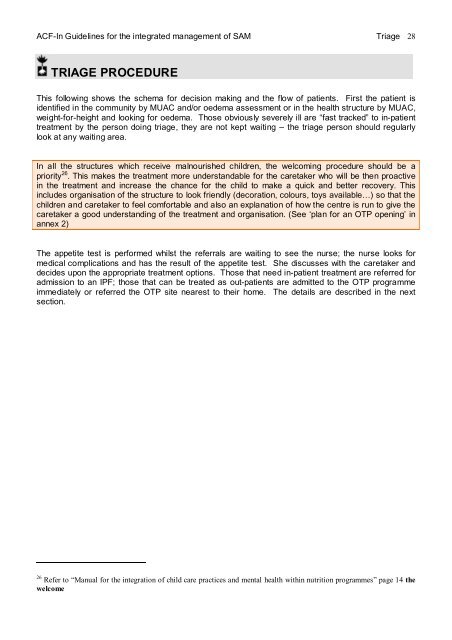guidelines for the integrated management of severe acute malnutrition
guidelines for the integrated management of severe acute malnutrition
guidelines for the integrated management of severe acute malnutrition
Create successful ePaper yourself
Turn your PDF publications into a flip-book with our unique Google optimized e-Paper software.
ACF-In Guidelines <strong>for</strong> <strong>the</strong> <strong>integrated</strong> <strong>management</strong> <strong>of</strong> SAM Triage 28<br />
TRIAGE PROCEDURE<br />
This following shows <strong>the</strong> schema <strong>for</strong> decision making and <strong>the</strong> flow <strong>of</strong> patients. First <strong>the</strong> patient is<br />
identified in <strong>the</strong> community by MUAC and/or oedema assessment or in <strong>the</strong> health structure by MUAC,<br />
weight-<strong>for</strong>-height and looking <strong>for</strong> oedema. Those obviously <strong>severe</strong>ly ill are “fast tracked” to in-patient<br />
treatment by <strong>the</strong> person doing triage, <strong>the</strong>y are not kept waiting – <strong>the</strong> triage person should regularly<br />
look at any waiting area.<br />
In all <strong>the</strong> structures which receive malnourished children, <strong>the</strong> welcoming procedure should be a<br />
priority 26 . This makes <strong>the</strong> treatment more understandable <strong>for</strong> <strong>the</strong> caretaker who will be <strong>the</strong>n proactive<br />
in <strong>the</strong> treatment and increase <strong>the</strong> chance <strong>for</strong> <strong>the</strong> child to make a quick and better recovery. This<br />
includes organisation <strong>of</strong> <strong>the</strong> structure to look friendly (decoration, colours, toys available…) so that <strong>the</strong><br />
children and caretaker to feel com<strong>for</strong>table and also an explanation <strong>of</strong> how <strong>the</strong> centre is run to give <strong>the</strong><br />
caretaker a good understanding <strong>of</strong> <strong>the</strong> treatment and organisation. (See ‘plan <strong>for</strong> an OTP opening’ in<br />
annex 2)<br />
The appetite test is per<strong>for</strong>med whilst <strong>the</strong> referrals are waiting to see <strong>the</strong> nurse; <strong>the</strong> nurse looks <strong>for</strong><br />
medical complications and has <strong>the</strong> result <strong>of</strong> <strong>the</strong> appetite test. She discusses with <strong>the</strong> caretaker and<br />
decides upon <strong>the</strong> appropriate treatment options. Those that need in-patient treatment are referred <strong>for</strong><br />
admission to an IPF; those that can be treated as out-patients are admitted to <strong>the</strong> OTP programme<br />
immediately or referred <strong>the</strong> OTP site nearest to <strong>the</strong>ir home. The details are described in <strong>the</strong> next<br />
section.<br />
26 Refer to “Manual <strong>for</strong> <strong>the</strong> integration <strong>of</strong> child care practices and mental health within nutrition programmes” page 14 <strong>the</strong><br />
welcome

















